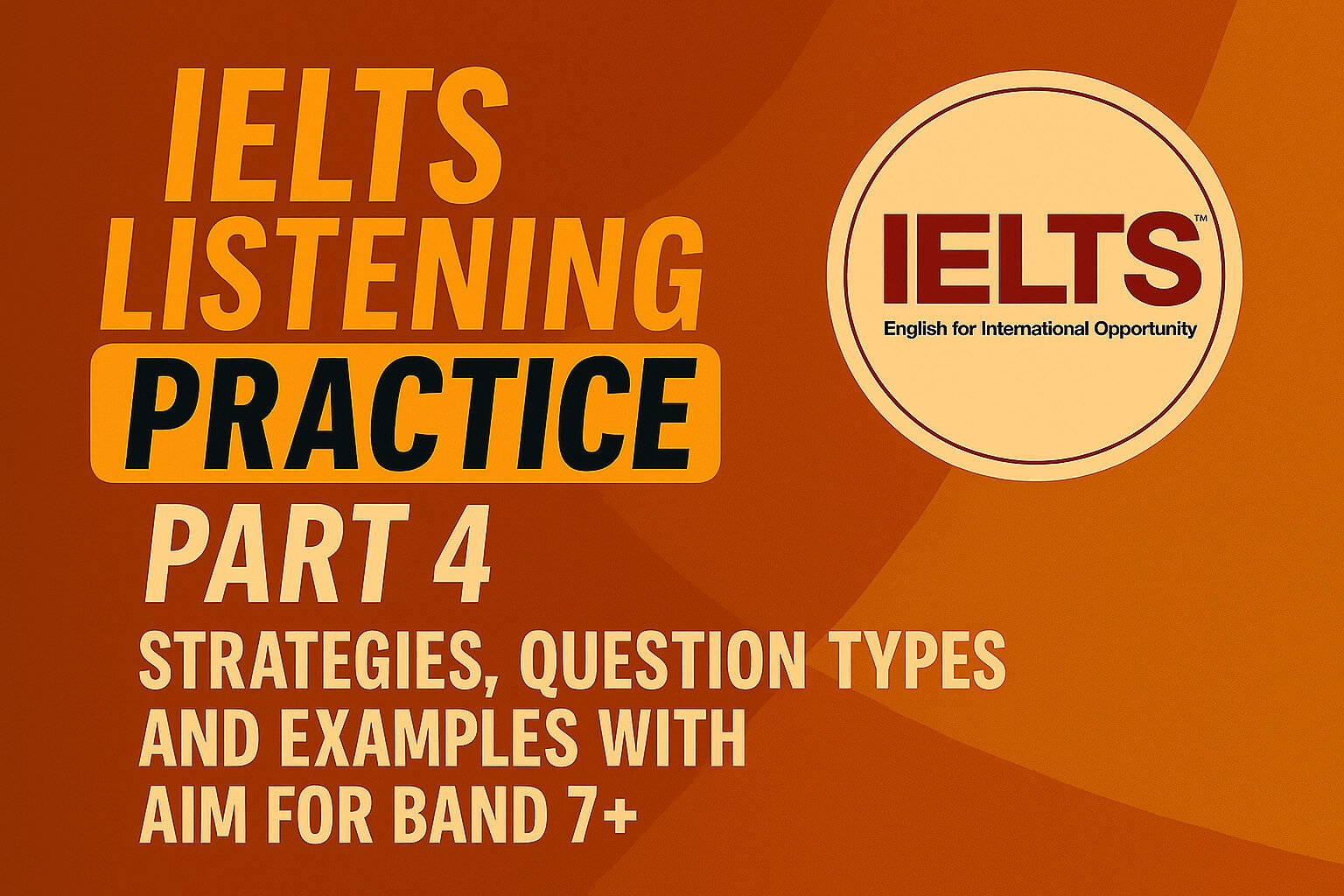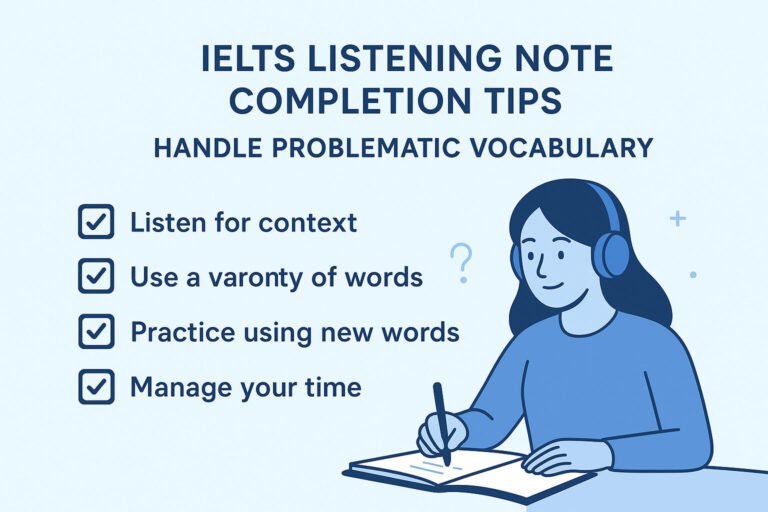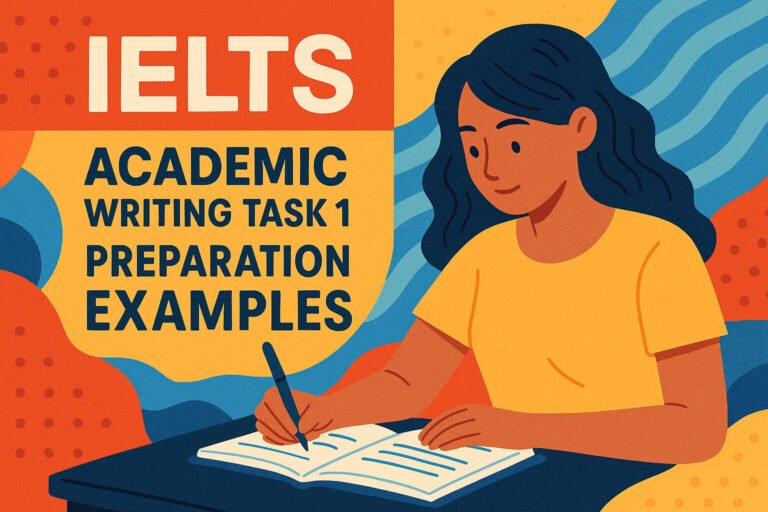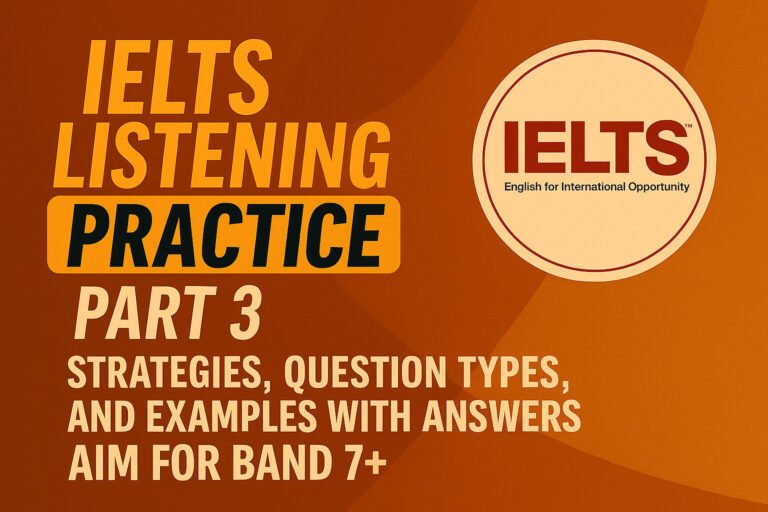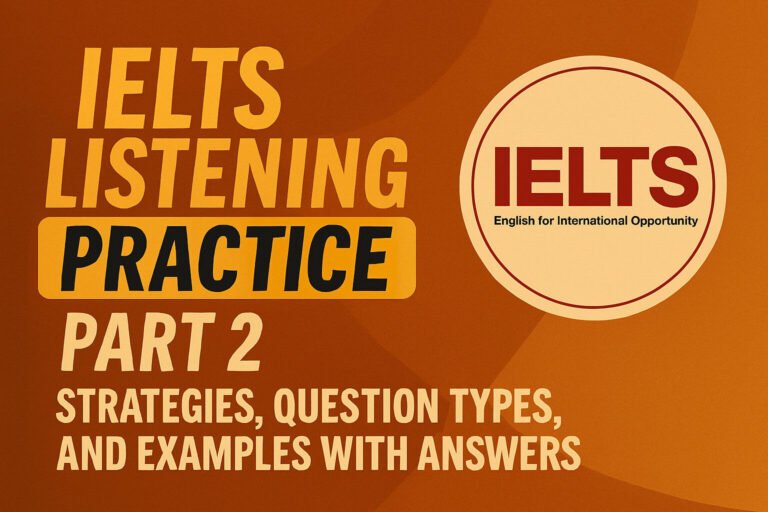Master IELTS listening practice part 4 with strategies, question types, and examples with answers. Aim for band 7+—start your free practice today!. Struggling to keep up with the academic lectures in IELTS Listening Part 4? Many aspirants find this section daunting due to its complex vocabulary and single-speaker format. This guide on IELTS listening practice part 4 will provide you with practical strategies, question types, and examples to master it. You’ll build the skills needed to achieve a higher band score with ease.
We’ll break down the structure, offer tips, and include exercises to turn this challenge into a success. Let’s get you ready to shine!
What is IELTS Listening Part 4? A Simple Breakdown
IELTS Listening Part 4 is the final section, featuring a monologue by one speaker, often a university lecturer or expert. It lasts about 3-4 minutes with 10 questions, played once. Topics cover academic subjects like science, history, or technology.
This part tests your ability to understand main ideas, specific details, and opinions in a formal context. IELTS listening practice part 4 is crucial to handle its advanced language. Use preview time to skim questions and prepare.
With practice, this section becomes manageable and boosts your overall score.
Why IELTS Listening Practice Part 4 is Essential
Regular IELTS listening practice part 4 helps you adapt to academic monologues and technical terms. Many lose marks by missing key points due to unfamiliar vocabulary or speed.
Practice improves your focus and prediction skills, key for following a lecture’s flow. It also builds confidence for the test’s toughest part. Consistent effort turns this into your strength.
Think of it as training for real classroom listening—start today!
Common IELTS Listening Part 4 Question Types
Knowing IELTS listening part 4 question types is vital for success. This section often includes completion tasks and multiple choice that demand attention to detail.
Here are the main IELTS listening question types with examples:
- Note Completion: Fill gaps in lecture notes. Example: “Main topic: ________”.
- Summary Completion: Complete a short paragraph. Example: “The study focuses on ________ effects.”
- Multiple Choice: Choose from A, B, C, or D. Example: “What is the lecturer’s view? A) Positive B) Negative C) Neutral”.
- Sentence Completion: Fill blanks in sentences. Example: “The experiment used ________ methods.”
- Diagram Labelling: Label parts of a diagram. Example: Mark stages of a process.
- Short Answer Questions: Answer in 1-2 words. Example: “What is the result?”
These IELTS listening part 4 question types with answers help you practice precision. Always respect word limits, like “no more than two words.”
Effective Strategies for IELTS Listening Practice Part 4
To excel, preview questions during the 30-second pause to predict answers. Focus on keywords like “cause” or “result” to guide your listening.
Listen for structure cues, like “firstly” or “in conclusion,” to follow the lecture. Take quick notes on main ideas, avoiding long sentences.
Check answers during transfer time to fix mistakes. Action step: Practice one audio daily with a timer to build stamina.
Stay calm if you miss a point—keep listening for the next.
IELTS Listening Part 4 Question Types with Answers: Real Examples
Let’s try IELTS listening part 4 question types with answers using a sample on climate change.
Example 1: Note Completion
Complete the notes. Write NO MORE THAN TWO WORDS AND/OR A NUMBER.
Main cause: (31) ________ gases
Impact: Rising (32) ________
Solution: (33) ________ energy
Answers: (31) greenhouse (32) temperatures (33) renewable
Tip: Note technical terms carefully.
Example 2: Multiple Choice
Choose the correct letter, A, B, C, or D.
What does the lecturer emphasize?
A) Past trends
B) Future risks
C) Current data
D) Old methods
Answer: B) Future risks
In audio: “We must focus on future risks of climate change.”
Example 3: Diagram Labelling
Label the diagram. Write NO MORE THAN TWO WORDS.
Diagram: Carbon Cycle
- ________ (process starts here)
- ________ (absorbed by)
- ________ (released back)
Answers: (34) Photosynthesis (35) Plants (36) Respiration
These IELTS listening question types with examples show how to match audio to tasks.
Free IELTS Listening Practice Part 4 Exercises
Try this IELTS listening practice part 4 exercise on a biology lecture.
Questions 37-40: Sentence Completion
Complete the sentences. Write NO MORE THAN TWO WORDS.
- The study examines ________ cells.
- Results show a ________ increase.
- The experiment used ________ tools.
- Future research needs ________ funding.
Hypothetical answers: 37. stem 38. significant 39. advanced 40. more
Practice: Use free audios from Cambridge IELTS or British Council.
Another: Summary completion on a history talk.
Fill gaps: The era saw (41) ________ wars and (42) ________ trade.
Answers: (41) frequent (42) growing
Do these daily to improve.
Mastering Academic Monologues in Part 4
Follow the speaker’s logic by noting introductions and conclusions. Predict based on question stems, like “cause” suggesting “pollution.”
Focus on emphasized words for main ideas. In IELTS listening practice part 4, replay audios to catch missed details.
Action: Summarize lectures in your own words after listening.
Vocabulary for IELTS Listening Part 4 Topics
Academic topics include science, history, or environment. Learn words: Hypothesis (theory), Data (facts), Analysis (study).
LSI: “lecture comprehension,” “academic audio.”
Add to notes during practice for recognition.
Advanced Techniques for Band 7+ in Part 4
For higher scores, anticipate synonyms— “increase” for “rise.” Ignore examples unless relevant.
Use IELTS listening practice part 4 with distractions to simulate focus. Review transcripts to learn from errors.
Table: IELTS Listening Part 4 Question Types Overview
| Type | Description | Example Focus | Strategy |
|---|---|---|---|
| Note Completion | Fill lecture notes | Causes | Predict terms |
| Summary Completion | Gap fill paragraph | Impacts | Use context |
| Multiple Choice | Select best | Opinions | Read options |
| Sentence Completion | Fill sentences | Methods | Stick to limits |
| Diagram Labelling | Label diagram | Process stages | Visualize |
| Short Answer | Brief response | Results | Be concise |
This table guides your IELTS listening part 4 question types practice.
Avoiding Common Mistakes in Part 4
Don’t get lost in details—focus on question focus. Many misspell technical terms; practice dictation.
Missing transitions costs points; listen for “next” or “however.” In practice, analyze errors to improve.
Tip: Use academic podcasts for extra exposure.
Your Daily IELTS Listening Practice Part 4 Plan
Day 1-3: Practice one type, like note completion.
Day 4-6: Full Part 4 tests, time yourself.
Week 2: Review transcripts, aim for 8/10.
Resources: Free samples from IELTS official sites.
FAQ: Your IELTS Listening Practice Part 4 Questions Answered
What are the main IELTS listening part 4 question types?
Key types include note completion, multiple choice, and diagram labelling. Practice examples to master them.
Where can I find IELTS listening part 4 question types with answers?
Check British Council or Cambridge IELTS books for free tests with answers.
Why is IELTS listening practice part 4 difficult?
Complex vocabulary and lectures make it tough. Regular practice builds understanding.
How long is the Part 4 audio?
About 3-4 minutes with 10 questions. Preview in 30 seconds.
What if I miss a whole section?
Guess and move on. Use transfer time to fill blanks logically.
How can I improve academic vocabulary for Part 4?
Listen to TED Talks or read journals, noting new words daily.
With this IELTS listening practice part 4 guide, you’re set to succeed. Keep practicing, stay motivated, and visit IELTSNest.com for more. You’ve got this!

